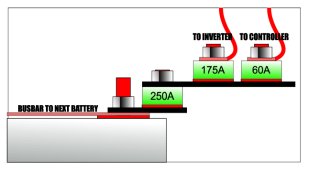Thanks!
Re: fuses, I'm planning to use a terminal fuse as the main fuse so I can connect it right to the battery bank positive, and branch from there. Maybe a good way to do it would be to have the main terminal fuse be rated at 250A, and then have a 175A fuse after that goes to the inverter, and another branch with a 60A fuse that goes to the charge controller. So maybe like a double terminal fuse holder on top of a single terminal fuse directly on the battery terminal. Does that make sense?
Should I move my further questions to a new thread??
Re: fuses, I'm planning to use a terminal fuse as the main fuse so I can connect it right to the battery bank positive, and branch from there. Maybe a good way to do it would be to have the main terminal fuse be rated at 250A, and then have a 175A fuse after that goes to the inverter, and another branch with a 60A fuse that goes to the charge controller. So maybe like a double terminal fuse holder on top of a single terminal fuse directly on the battery terminal. Does that make sense?
Should I move my further questions to a new thread??
Last edited:





